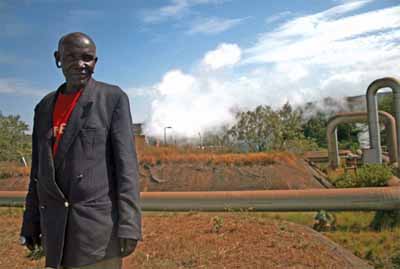
Environmental Impacts
Geothermal energy is considered a renewable resource which can be used sustainably. Renewability is a characteristic of a resource while sustainability relates to the manner in which the resource is utilized (Rybach 2007, 2). Geothermal energy is renewable because the Earth is continually producing heat. Sustainable production rates can be found that allow for long term utilization followed by practical (95%) resource recovery on time scales of technological and societal systems, i.e. a generation to several hundred years, as opposed to the geological time scale of thousands of years needed for fossil fuel recovery (Rybach 2007, Rybach 2003). However, recovery is asymptotic, fast initially and then slowing down such that absolute recovery theoretically takes an infinite amount of time. Practical recovery, i.e. 95%, is generally achieved much more quickly on a time scale of 30 years to several hundred years.
Power plants have greater environmental impacts than district heating systems, which in turn have greater impacts than geothermal heat pumps. The impacts of geothermal power plants include changes to landscape; emissions into the atmosphere, surface and subsurface waters; noise; land subsidence, seismicity; and solid waste. The impact is generally proportional to the rate of fluid extraction.
The potential for air pollution is primarily an issue only for power production. Geothermal fluids contain dissolved gases including carbon dioxide (CO2) and hydrogen sulfide (H2S). Depending on the resource, they may also contain small amounts of ammonia, hydrogen, nitrogen, methane, radon, and of volatile species of boron, arsenic, and mercury. However, “Geothermal power provides significant environmental advantages over fossil fuel power sources in terms of air emissions because geothermal energy production releases no nitrogen oxides (NOx), no sulfur dioxide (SO2), and much less carbon CO2 than fossil-fueled power” (http://www.repp.org/geothermal/geothermal_brief_environmental_impacts.html). Air pollution can be virtually eliminated by the use of binary power plant design. Binary power plants emit no CO2. CO2 emissions for dry steam and flash plants are .02 pounds per kilowatt-hour (lb/kWh), compared to 1.32 lb/kWh from natural gas, 1.97 lb/kWh from oil, and 2.09 lb/kWh from coal.
Water use is an issue with conventional power plants. Even though geothermal plants use water and steam as fuel they use less water than coal, oil or nuclear plants. For geothermal generation, dry steam and flash plants use about 20 liters of freshwater per megawatt-hour of electricity (MWhe) produced, while binary air-cooled plants use no fresh water. This is an extremely low amount compared to coal plants which use 1,370 liters per MWh e, oil plants which use about 1160 liters per MWhe or nuclear plants which use about 1700 liters per MWhe (Lund 2006, 50). In the case of direct-use application, the discharge of effluent is a potential source of pollution. Low and moderate temperature geothermal fluids, usually used in direct-use applications, typically contain low levels of chemicals and the discharge of effluent is rarely a major problem (Dickson and Fanelli 2004, 55). Thermal pollution is a concern, particularly for aquatic environments, and a 2 to 3 °C increase in the temperature of a body of water as a result of discharging effluent could damage an ecosystem. For example, “The plant and animal organisms that are most sensitive to temperature variations could gradually disappear, leaving a fish species without its food source” (Dickson and Fanelli 2004, 53). Holding ponds or tanks can be used to cool effluent before it is released into lakes or rivers. Waste water is often re-injected into the geothermal aquifer. Reinjection can cause minor earthquakes. Increasing volumes of injection fluid tend to lead to more frequent tremors but not more severe ones. In a Hot Dry Rock system, a geothermal reservoir is created by fracturing hot dry rock deep underground and circulating water through injection and extraction wells. The steam that is produced is used for creating electricity. Hydraulic fracturing used in Hot Dry Rock systems can induce earthquakes of 2 to 3 magnitudes (Ryback 2003, 468).
Although binary geothermal power plants emit very low emissions they create significant waste heat. Cogeneration in which the waste heat is utilized for producing power or heating, and the implementation of cascading uses is recommended to reduce the amount of waste heat. Cascading uses is the use of geothermal wastewater for multiple applications at decreasing temperatures. For example, wastewater from power generation is still hot enough to be used for space heating, followed by agricultural use, balneology, and finally fish farming.
 |
A Maasai tribesman stands near a section of the geothermal energy plant in Hell's Gate Naivasha, Kenya Source: Allianz.com |
Geothermal power plants and direct uses of geothermal energy have land use impacts, though geothermal power plants have much smaller footprints than nuclear or coal plants. Land use impacts are further reduced compared to fossil fuel plants because the fuel does not have to be mined and transported by road or rail. Geothermal plants can coexist with wildlife and have minimal impact on natural habitat. According to the Renewable Energy Policy Project (REPP):
Geothermal plants can be sited in farmland and forests and can share land with cattle and local wildlife. For example, the Hell’s Gate National Park in Kenya was established around an existing 45-MWe geothermal power station, Olkaria I. Land uses in the park include livestock grazing, growing of foodstuffs and flowers, and conservation of wildlife and birds within the Park. After extensive environmental impact analysis, a second geothermal plant, Olkaria II, was approved for installation in the park in 1994, and an additional power station is under consideration (www.repp.org/geothermal/geothermal_brief_environmental_impacts.html).
Geothermal project developers must be careful not to alter geysers, hot springs, or other culturally significant features (Lund 2006, 51).